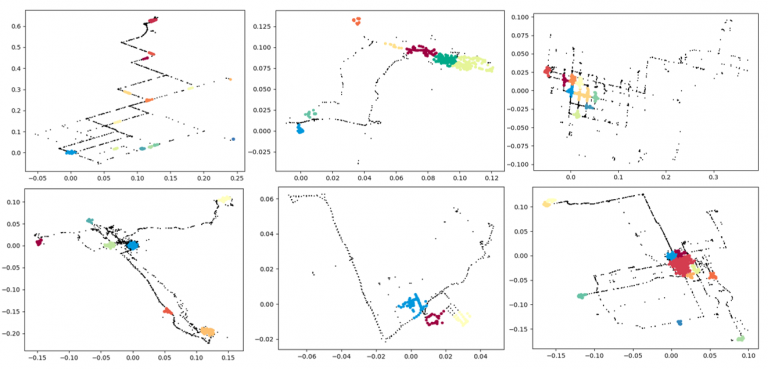GPS-based Analysis of Wandering Patterns of Individuals with Alzheimer’s
(Wojtusiak, Mogharab Nia, Tompkins, Middle, Pfoser, Bagchi, Koester, Durai)
Significant number of people with dementia are at risk of wandering and getting lost. These individuals may get hurt, cause distress to families and caregivers, and require costly search parties. The goal of this research is to explore how advanced technology can help find missing individuals when they get lost. We use artificial intelligence (AI) system that models movement of a person with dementia using machine learning methods and predicts where a person is likely to be.
In order to achieve this goal, the system needs to learn from past movements of a person with dementia. A person wears a GPS tracker to collect data on how typical movements happen. In the research study we also ask caregivers of the study participants to keep a journal of the actual incidents of getting lost. After a few weeks of using the tracker (the actual time depends on specific parson) the system has enough data to start predicting where a person is likely to be and where to search if that person is lost.
But why to predict if trackers are used? Most trackers available on the market provide real-time monitoring and features such as geofencing. When a person with dementia gets lost, caregivers or search and rescue personnel can find current location. But the devices are not always worn, may not be charged, or may be out of range. Our project allows for predicting locations even if the device is not worn at a given time.
Beyond location prediction, we believe that the patterns of movement can be linked to the progression of Alzheimer’s Disease and dementia. We are enrolling participants in a study that aims at collecting longitudinal GPS tracker data along with surveys and journal of wandering events to allow for testing this hypothesis.
How does it work? We have developed a multi-step algorithm that learns patterns of movement and then applies them when needed. First, data are cleaned and transformed. Then frequent locations are detected using spatiotemporal clustering (we use a modified version of DBSCAN) and models for predicting these frequent locations are built. Then, the work focuses on using local movement trajectories within the areas of frequent locations and between them. Some of the work is described by Wojtusiak and Mogharab Nia (2019) and other publications that can be found in the papers section.
The figures below show frequently visited locations for selected example devices. Note that the data are normalized and randomly transformed the data to ensure privacy.

The video below shows how a hypothetical person with dementia moves between previously visited frequent locations indicated by circles. It also shows how an individualized model built for that person predicts where are the most likely locations that person may be, assuming the person is not at home.
References
Wojtusiak, J., Bagchi, P., B. Durai, U. N., Koester, R. J., Middle, B. , Mogharab Nia, R. and Tompkins, C., “Analysis of Wandering Patterns of Individuals with Alzheimers Disease,” Reports of the Machine Learning and Inference Laboratory, MLI 20-3, 2020.
Mogharab Nia, R. and Wojtusiak, J., “Using Landmark Information to Enhance Location Prediction for Missing People with Alzheimer’s Disease,” Poster Presentation at American Medical Informatics Annual Symposium, November. 2020.
Wojtusiak, J. and Mogharab Nia, R., “Location Prediction Using GPS Trackers: Can Machine Learning Help Locate the Missing People with Dementia?,” Internet of Things, Elsevier, 2019 (in press).
Wojtusiak, J., B. Durai, U. N., Koester, R. J., Middle, B. , Mogharab Nia, R. and Tompkins, C., “Using GPS to Locate the Missing and Track Wandering in People with Alzheimer’s Disease,” AMIA, 2019.
Wojtusiak, J. and Mogharab Nia, R., “Location Prediction Using GPS Trackers: Towards Predicting Wandering in People with Dementia,”Reports of the Machine Learning and Inference Laboratory, MLI 18-1, 2018.
